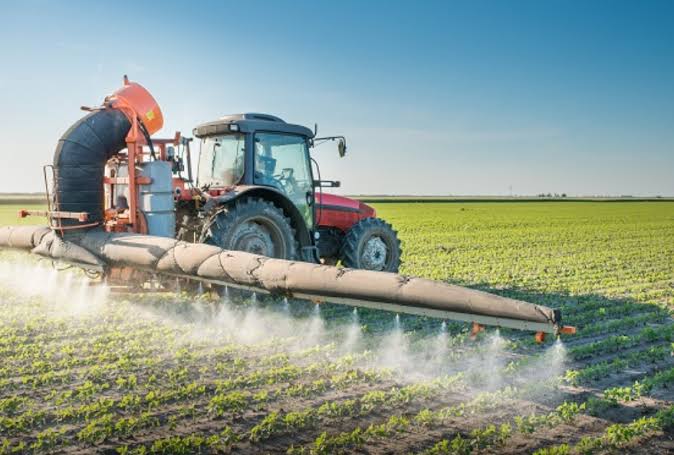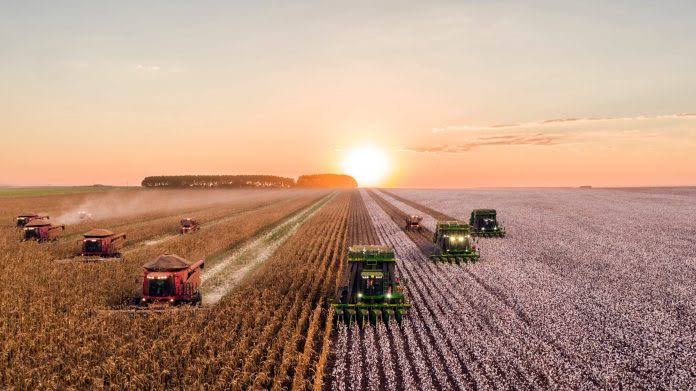Industrial agriculture refers to the large-scale, mechanized production of crops and livestock, employing modern technology and techniques to maximize efficiency. In recent decades, it has become the predominant method of farming in many parts of the world. This shift has brought about both advantages and concerns, shaping the landscape of global food production.
The key characteristic of industrial agriculture is its reliance on machinery, such as tractors and harvesters, to perform tasks that were traditionally done by hand. This mechanization has significantly increased the scale of farming operations, allowing for the cultivation of vast expanses of land. Large fields of monoculture, where a single crop is grown extensively, have become a hallmark of industrial agriculture.
One of the primary benefits of industrial agriculture is its ability to generate high yields. Through the use of synthetic fertilizers, pesticides, and genetically modified organisms, farmers can optimize the growth of crops, ensuring a more abundant harvest. This has played a crucial role in meeting the ever-growing global demand for food, especially in densely populated areas.
However, the widespread adoption of industrial agriculture has raised environmental concerns. The heavy use of chemical inputs can lead to soil degradation and water pollution, impacting the long-term sustainability of farming practices. Additionally, the focus on monoculture can make crops more susceptible to diseases and pests, necessitating even greater use of pesticides.
Livestock production within the realm of industrial agriculture has also undergone significant changes. Large-scale confinement operations, known as factory farms, are common in this model.
These facilities aim to maximize efficiency and reduce costs by housing animals in tightly controlled environments. While this approach has increased meat production, it has raised ethical concerns about animal welfare and the use of antibiotics to promote growth.
The economic implications of industrial agriculture are complex. On one hand, it has contributed to economic growth by creating jobs and driving innovation in the agricultural sector. On the other hand, the consolidation of farms into larger, more mechanized operations has led to the decline of small family farms, impacting rural communities.
Efforts to address the drawbacks of industrial agriculture have given rise to alternative approaches, such as sustainable farming and organic agriculture. These methods prioritize environmental stewardship, biodiversity, and the well-being of animals. While they may not match the scale of industrial agriculture, proponents argue that they offer a more balanced and ecologically friendly approach to food production.
In addition, industrial agriculture has become a dominant force in global food production, shaping the way we grow crops and raise livestock. Its efficiency in meeting the demands of a growing population is evident, but the environmental and ethical concerns associated with this model highlight the need for a more sustainable and holistic approach to farming.
Read Also: A Guide to Growing and Caring for Korean Grass (Zoysia Japonica)
Importance of Industrial Agriculture

The importance of industrial agriculture lies in its capacity to meet the escalating global demand for food by employing advanced technologies and large-scale production methods. This approach plays a crucial role in supporting the growing population and ensuring food security in many parts of the world.
One significant aspect is the ability of industrial agriculture to achieve high yields. Through the implementation of modern farming techniques, such as mechanization, synthetic fertilizers, and genetically modified organisms, farmers can optimize crop production. This increased efficiency is essential for feeding densely populated regions and addressing the challenges of food shortages.
Furthermore, industrial agriculture contributes to economic development by creating jobs and fostering innovation in the agricultural sector. The mechanization and scale of operations lead to increased productivity, generating economic growth in both rural and urban areas. The sector’s expansion can also have a multiplier effect, stimulating related industries and supporting overall economic stability.
The efficiency of industrial agriculture in producing large quantities of food at competitive prices has helped alleviate poverty and improve living standards for many people. By streamlining the production process, it has made food more accessible and affordable for a broader segment of the population.
Despite these advantages, the importance of industrial agriculture is accompanied by environmental and ethical challenges. The heavy reliance on chemical inputs can lead to soil degradation and water pollution, raising concerns about long-term sustainability.
Additionally, the use of confined animal feeding operations (CAFOs) in livestock production has sparked debates about animal welfare and the ethical implications of mass-scale farming practices.
As the world faces the dual challenges of feeding a growing population and addressing environmental concerns, the importance of industrial agriculture has prompted discussions on the need for more sustainable and responsible farming practices. This includes exploring alternative approaches like organic farming and sustainable agriculture, which prioritize environmental health, biodiversity, and ethical considerations.
The importance of industrial agriculture is evident in its ability to meet the global demand for food, drive economic development, and improve living standards. However, it is crucial to address the associated environmental and ethical issues to ensure a more sustainable and balanced approach to food production for the benefit of current and future generations.
Economic Implications of Industrial Agriculture
The economic implications of industrial agriculture are multifaceted and have significant impacts on both local and global scales. Here are some key aspects to consider:
1. Job Creation and Economic Growth: Industrial agriculture, with its large-scale operations and mechanization, contributes to job creation in rural areas. The need for skilled workers in operating machinery, managing crops, and handling logistics stimulates local economies. Additionally, the sector’s expansion can lead to overall economic growth by generating income, tax revenues, and fostering innovation.
2. Efficiency and Productivity: The mechanized nature of industrial agriculture enhances efficiency and productivity. Larger yields per acre and streamlined processes result in increased output, reducing the overall cost of production. This economic efficiency helps ensure a stable and affordable food supply for consumers.
3. Market Competitiveness: Industrial agriculture often leads to the consolidation of farms into larger, more competitive operations. While this enhances the sector’s ability to meet market demands, it can also pose challenges for smaller, traditional farms that may struggle to compete economically.
4. Global Trade and Agricultural Exports: Industrial agriculture is a key player in global agricultural trade. Countries with advanced industrial farming practices often become major exporters of agricultural products, contributing to their economic standing on the international stage. This trade can lead to economic interdependence but may also create vulnerabilities in the face of global market fluctuations.
5. Challenges for Small Family Farms: The dominance of industrial agriculture can negatively impact small family farms. As larger operations become more prevalent, small-scale farmers may face challenges in competing economically. This can lead to the decline of traditional farming communities and impact the social fabric of rural areas.
6. Technology and Innovation: The economic implications of industrial agriculture extend to technology and innovation. Continuous advancements in agricultural technology, including precision farming, biotechnology, and data-driven approaches, drive economic growth and competitiveness within the sector.
7. Environmental Externalities: While industrial agriculture brings economic benefits, it also generates environmental externalities. The economic costs associated with soil degradation, water pollution, and the loss of biodiversity may not be immediately apparent but can have long-term consequences, impacting ecosystems and potentially leading to economic challenges in the future.
8. Government Subsidies and Policies: Economic implications are influenced by government policies and subsidies. Many governments provide financial support to the agricultural sector, including subsidies for specific crops and incentives for adopting certain technologies. These policies can shape the economic landscape of industrial agriculture.
The economic implications of industrial agriculture are significant, influencing job markets, global trade dynamics, and the overall economic well-being of regions. While it contributes to increased efficiency and productivity, attention must be given to the potential challenges faced by smaller farms and the long-term environmental and social impacts associated with this model of farming.
Read Also: A Guide to Growing and Caring for Helictotrichon Sempervirens (Blue Oat Grass)
Mechanization and Modern Technology

Mechanization and modern technology are pivotal components of industrial agriculture, revolutionizing traditional farming practices and shaping the contemporary landscape of food production. The integration of machinery and advanced technologies has had profound implications on efficiency, productivity, and the overall dynamics of agricultural systems.
1. Tractors and Equipment: Mechanization in industrial agriculture is epitomized by the widespread use of tractors and specialized equipment. These machines perform tasks such as plowing, planting, and harvesting, replacing manual labor and significantly increasing the scale of farming operations.
2. Precision Farming: Modern technology plays a crucial role in precision farming, where satellite imagery, GPS systems, and sensor technologies are employed to optimize crop management. This approach enables farmers to apply resources such as water, fertilizers, and pesticides more efficiently, reducing waste and environmental impact.
3. Drones and Remote Sensing: Drones equipped with cameras and sensors are increasingly used for monitoring crop health and assessing field conditions. This aerial perspective allows for early detection of issues such as pest infestations or nutrient deficiencies, enabling timely intervention.
4. Genetic Engineering and Biotechnology: Advances in genetic engineering and biotechnology have given rise to genetically modified organisms (GMOs). These crops are designed to resist pests, diseases, or harsh environmental conditions, contributing to increased yields and enhanced crop resilience.
5. Automated Systems and Robotics: Automation and robotics are becoming integral to various aspects of farming. From autonomous tractors to robotic harvesters, these technologies streamline operations, reduce labor requirements, and improve the precision of tasks like fruit picking and sorting.
6. Data Analytics and Farm Management Software: The use of data analytics and farm management software has become commonplace in modern agriculture. Farmers can analyze data on weather patterns, soil health, and crop performance to make informed decisions, optimize resource allocation, and enhance overall farm efficiency.
7. Biological Control and Integrated Pest Management: Modern technology facilitates the implementation of biological control methods and integrated pest management strategies. This involves the targeted use of natural predators and beneficial organisms to control pests, reducing reliance on chemical pesticides.
8. Vertical Farming and Controlled Environment Agriculture: Technological innovations have led to the development of vertical farming and controlled environment agriculture, where crops are grown indoors in precisely controlled conditions. This approach minimizes the impact of external factors, allowing for year-round production and resource-efficient cultivation.
9. Challenges and Considerations: While mechanization and modern technology bring undeniable benefits, challenges include the high initial costs of advanced equipment, potential job displacement, and the need for sustainable practices to mitigate environmental impact.
Striking a balance between technological advancements and environmental stewardship is a critical consideration in the evolution of industrial agriculture.
In conclusion, the marriage of mechanization and modern technology has transformed agriculture into a highly efficient and technologically advanced industry. As these innovations continue to evolve, they hold the promise of addressing global food demands while necessitating careful consideration of their broader implications on sustainability and societal well-being.
Read Also: Introducing the Mr Cool DIY Mini Split: A Breath of Fresh Air in Home Comfort





